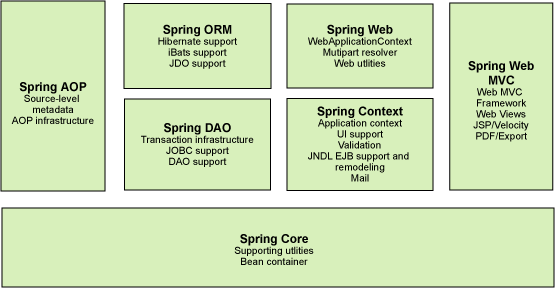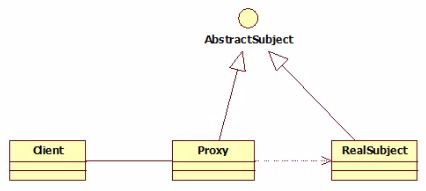Spring5教程-从入门到精通
Spring
1.1、 简介
依赖:Spring Web MVC
<dependency>
<groupId>org.springframeworkgroupId>
<artifactId>spring-webmvcartifactId>
<version>5.2.3.RELEASEversion>
dependency>
<dependency>
<groupId>org.springframeworkgroupId>
<artifactId>spring-jdbcartifactId>
<version>5.2.3.RELEASEversion>
dependency>
1.2、 优点
- Spring是一个开源免费的框架 , 容器 .
- Spring是一个轻量级的框架 , 非侵入式的 .
- 控制反转 IoC , 面向切面 Aop
- 对事物的支持 , 对框架的支持
1.3、组成
- 核心容器:核心容器提供 Spring 框架的基本功能。核心容器的主要组件是
BeanFactory,它是工厂模式的实现。BeanFactory使用控制反转(IOC) 模式将应用程序的配置和依赖性规范与实际的应用程序代码分开。 - Spring 上下文:Spring 上下文是一个配置文件,向 Spring 框架提供上下文信息。Spring 上下文包括企业服务,例如 JNDI、EJB、电子邮件、国际化、校验和调度功能。
- Spring AOP:通过配置管理特性,Spring AOP 模块直接将面向切面的编程功能 , 集成到了 Spring 框架中。所以,可以很容易地使 Spring 框架管理任何支持 AOP的对象。Spring AOP 模块为基于 Spring 的应用程序中的对象提供了事务管理服务。通过使用 Spring AOP,不用依赖组件,就可以将声明性事务管理集成到应用程序中。
- Spring DAO:JDBC DAO 抽象层提供了有意义的异常层次结构,可用该结构来管理异常处理和不同数据库供应商抛出的错误消息。异常层次结构简化了错误处理,并且极大地降低了需要编写的异常代码数量(例如打开和关闭连接)。Spring DAO 的面向 JDBC 的异常遵从通用的 DAO 异常层次结构。
- Spring ORM:Spring 框架插入了若干个 ORM 框架,从而提供了 ORM 的对象关系工具,其中包括 JDO、Hibernate 和 iBatis SQL Map。所有这些都遵从 Spring 的通用事务和 DAO 异常层次结构。
- Spring Web 模块:Web 上下文模块建立在应用程序上下文模块之上,为基于 Web 的应用程序提供了上下文。所以,Spring 框架支持与 Jakarta Struts 的集成。Web 模块还简化了处理多部分请求以及将请求参数绑定到域对象的工作。
- Spring MVC 框架:MVC 框架是一个全功能的构建 Web 应用程序的 MVC 实现。通过策略接口,MVC 框架变成为高度可配置的,MVC 容纳了大量视图技术,其中包括 JSP、Velocity、Tiles、iText 和 POI。
2、IOC基础
控制反转IoC(Inversion of Control),是一种设计思想,DI(依赖注入)是实现IoC的一种方法。没有IoC的程序中 , 我们使用面向对象编程 , 对象的创建与对象间的依赖关系完全硬编码在程序中,对象的创建由程序自己控制,控制反转后将对象的创建转移给第三方,个人认为所谓控制反转就是:获得依赖对象的方式反转了。
IoC是Spring框架的核心内容,使用多种方式完美的实现了IoC,可以使用XML配置,也可以使用注解,新版本的Spring也可以零配置实现IoC。
Spring容器在初始化时先读取配置文件,根据配置文件或元数据创建与组织对象存入容器中,程序使用时再从Ioc容器中取出需要的对象。
控制反转是一种通过描述(XML或注解)并通过第三方去生产或获取特定对象的方式。在Spring中实现控制反转的是IoC容器,其实现方法是依赖注入(Dependency Injection,DI)。
3、HelloSpring
3.1、代码编写
Hello实体类:
public class Hello {
private String name;
public String getName() {
return name;
}
public void setName(String name) {
this.name = name;
}
public void show(){
System.out.println("Hello,"+ name );
}
}
编写spring文件,bean.xml
<beans xmlns="http://www.springframework.org/schema/beans"
xmlns:xsi="http://www.w3.org/2001/XMLSchema-instance"
xsi:schemaLocation="http://www.springframework.org/schema/beans
http://www.springframework.org/schema/beans/spring-beans.xsd">
<bean id="hello" class="com.kuang.pojo.Hello">
<property name="name" value="Spring"/>
bean>
beans>
测试:
@Test
public void test(){
//解析beans.xml文件 , 生成管理相应的Bean对象
ApplicationContext context = new ClassPathXmlApplicationContext("beans.xml");
//getBean : 参数即为spring配置文件中bean的id .
Hello hello = (Hello) context.getBean("hello");
hello.show();
}
3.2、分析
控制反转:将对象的创建者由程序转换为Spring,程序本身不创建对象,编程被动的接收对象。
依赖注入:本质上采用set方法进行注入,若将实体类中的setter方法注释,bean中会报错
我们实现不同的操作 , 只需在xml配置文件中进行修改 , 不需修改程序,所谓的IoC就是对象由Spring 来创建 , 管理 , 装配 !
4、IoC创建对象的方式
4.1、使用无参构造方法创建
bean.xml
<bean id="user" class="com.xyzhang.pojo.User">
<property name="name" value="xyzhang"/>
bean>
4.2、使用有参构造方法创建
实体类:
public class UserT {
private String name;
public UserT(String name) {
this.name = name;
}
public void setName(String name) {
this.name = name;
}
public void show(){
System.out.println("name="+ name );
}
}
bean.xml:
<bean id="userT" class="com.xyzhang.pojo.UserT">
<constructor-arg index="0" value="xyzhang"/>
bean>
<bean id="userT" class="com.xyzhang.pojo.UserT">
<constructor-arg name="name" value="xyzhang"/>
bean>
<bean id="userT" class="com.xyzhang.pojo.UserT">
<constructor-arg type="java.lang.String" value="xyzhang"/>
bean>
在配置文件加载时,容器中管理的对象就会进行初始化,无论后续是否使用。
5、Spring配置
5.1、别名Alias
设置别名后 在获取Bean时可以使用别名获取(bean中的name可实现相同效果)
5.2、Bean配置
<bean id="hello" name="hello2 h2,h3;h4" class="com.xyzhang.pojo.Hello">
<property name="name" value="Spring"/>
bean>
5.3、import
可以将多个配置文件导入合并为一个(适用于团队合作)
6、依赖注入DI
- 依赖 : 指Bean对象的创建依赖于容器 . Bean对象的依赖资源 .
- 注入 : 指Bean对象所依赖的资源属性 , 由容器来设置和装配 .
6.1、构造器注入
6.2、set方式注入【重点】
要求被注入的属性 , 必须要有setter
实体类:
Address.java
public class Address {
private String address;
public String getAddress() {
return address;
}
public void setAddress(String address) {
this.address = address;
}
}
Student.java
public class Student {
private String name;
private Address address;
private String[] books;
private List<String> hobbys;
private Map<String,String> card;
private Set<String> games;
private String wife;
private Properties info;
public void setName(String name) {
this.name = name;
}
public void setAddress(Address address) {
this.address = address;
}
public void setBooks(String[] books) {
this.books = books;
}
public void setHobbys(List<String> hobbys) {
this.hobbys = hobbys;
}
public void setCard(Map<String, String> card) {
this.card = card;
}
public void setGames(Set<String> games) {
this.games = games;
}
public void setWife(String wife) {
this.wife = wife;
}
public void setInfo(Properties info) {
this.info = info;
}
public void show(){
System.out.println("name="+ name
+ ",address="+ address.getAddress()
+ ",books="
);
for (String book:books){
System.out.print("<<"+book+">>\t");
}
System.out.println("\n爱好:"+hobbys);
System.out.println("card:"+card);
System.out.println("games:"+games);
System.out.println("wife:"+wife);
System.out.println("info:"+info);
}
}
- 常量注入
<bean id="student" class="com.xyzhang.pojo.Student">
<property name="name" value="小明"/>
bean>
- Bean注入(引用类型注入)
先在容器中创建出引用类型,通过ref在需要处引用
<bean id="addr" class="com.xyzhang.pojo.Address">
<property name="address" value="西大直街92号"/>
bean>
<bean id="student" class="com.xyzhang.pojo.Student">
<property name="name" value="小明"/>
<property name="address" ref="addr"/>
bean>
- 数组注入
<property name="books">
<array>
<value>西游记value>
<value>红楼梦value>
<value>水浒传value>
array>
property>
- 集合list注入
<property name="hobbys">
<list>
<value>听歌value>
<value>看电影value>
<value>爬山value>
list>
property>
- Map注入(采用key value键值对进行注入)
<property name="card">
<map>
<entry key="中国邮政" value="456456456465456"/>
<entry key="建设" value="1456682255511"/>
map>
property>
- 集合set注入
<property name="games">
<set>
<value>LOLvalue>
<value>BOBvalue>
<value>COCvalue>
set>
property>
- null注入
- properties注入
<property name="info">
<props>
<prop key="学号">20190604prop>
<prop key="性别">男prop>
<prop key="姓名">小明prop>
props>
property>
6.3、拓展方式注入
以下两种不能直接使用,需要导入xml头文件
-
P命名空间注入(不需使用构造器,默认无参构造器即可):需要在头文件中加入约束条件
导入约束 : xmlns:p="http://www.springframework.org/schema/p" <bean id="user" class="com.xyzhang.pojo.User" p:name="xyzhang" p:age="18"/> -
C命名空间注入(使用实体类中的有参构造器注入):需要在头文件中加入约束条件
导入约束 : xmlns:c="http://www.springframework.org/schema/c" <bean id="user" class="com.xyzhang.pojo.User" c:name="xyzhang" c:age="18"/>
6.4、Bean的作用域
后四种作用域仅在基于web的应用中使用(不必关心你所采用的是什么web应用框架),只能用在基于web的Spring ApplicationContext环境。
-
Singleton单例模式(Spring默认模式)
Spring IoC容器中只会存在一个共享的bean实例,并且所有对bean的请求,只要id与该bean定义相匹配,则只会返回bean的同一实例。Singleton是单例类型,就是在创建起容器时就同时自动创建了一个bean的对象,不管你是否使用,他都存在了,每次获取到的对象都是同一个对象。
-
Prototype原型模式
Prototype作用域的bean会导致在每次对该bean请求(将其注入到另一个bean中,或者以程序的方式调用容器的getBean()方法)时都会创建一个新的bean实例。Prototype是原型类型,它在我们创建容器的时候并没有实例化,而是当我们获取bean的时候才会去创建一个对象,而且我们每次获取到的对象都不是同一个对象。
-
Request
-
Session
-
application
7、Bean自动装配
7.1、配置方式:
- 在xml中显示配置;
- 在Java中显示配置;
- 隐式的bean发现机制和自动装配;
7.2、Spring的自动装配:
- 组件扫描(component scanning):spring会自动发现应用上下文中所创建的bean;
- 自动装配(autowiring):spring自动满足bean之间的依赖,也就是我们说的IoC/DI;
-
byName 按名称自动装配
修改bean的配置增加属性autowire=“byName”
<bean id="user" class="com.xyzhang.pojo.User" autowire="byName"> <property name="str" value="xyzhang"/> bean>当bean节点设置该属性后
- 将查找其类中所有的set方法名,例如setCat,获得将set去掉并且首字母小写的字符串,即cat。
- 在spring容器中寻找是否有此字符串名称id的对象。
- 如果有,就取出注入;如果没有,就报空指针异常。
-
byType 按类型自动装配
使用前需要保证,同一type的对象在spring容器中唯一,否则会报异常。
<bean id="user" class="com.xyzhang.pojo.User" autowire="byType"> <property name="str" value="xyzhang"/> bean>
7.3、使用注解实现自动装配
7.3.1、准备工作
- 添加注解所需的配置文件,在Spring配置文件中引入context文件头
- 开启属性注解支持
<beans xmlns="http://www.springframework.org/schema/beans"
xmlns:xsi="http://www.w3.org/2001/XMLSchema-instance"
xmlns:context="http://www.springframework.org/schema/context"
xsi:schemaLocation="http://www.springframework.org/schema/beans
https://www.springframework.org/schema/beans/spring-beans.xsd
http://www.springframework.org/schema/context
https://www.springframework.org/schema/context/spring-context.xsd">
<context:annotation-config/>
beans>
7.3.2、@Autowired【最常用】
可直接在属性上使用,也可在set方法上直接使用!
使用@Autowired注解可以不用编写setter方法,前提是自动装配的属性在IoC容器中存在,且符合名字byName!
实体类:
public class User {
@Autowired
private Cat cat;
@Autowired
private Dog dog;
private String str;
public Cat getCat() {
return cat;
}
public Dog getDog() {
return dog;
}
public String getStr() {
return str;
}
}
配置文件bean.xml
<bean id="dog" class="com.xyzhang.pojo.Dog"/>
<bean id="cat" class="com.xyzhang.pojo.Cat"/>
<bean id="user" class="com.xyzhang.pojo.User"/>
其中:@Autowired(required=false) required=false表示对象可以为null;true,对象不能为null。默认为true
7.3.3、@Qualifier
- @Autowired 是根据类型自动装配的,加上@Qualifier则可以根据byName的方式自动装配
- @Qualifier不能单独使用。
使用方法:
实体类:
@Autowired
@Qualifier(value = "cat1")
private Cat cat;
@Autowired
@Qualifier(value = "dog1")
private Dog dog;
bean.xml
<bean id="dog1" class="com.kuang.pojo.Dog"/>
<bean id="cat1" class="com.kuang.pojo.Cat"/>
7.3.4、@Resource
- @Resource如有指定的name属性,先按该属性进行byName方式查找装配;
- 其次再进行默认的byName方式进行装配;
- 如果以上都不成功,则按byType的方式自动装配。
- 都不成功,则报异常。
@Resource与@Autowired区别:
- 都可以用来装配Bean,都可以写在字段上,或写在setter方法上。
- @Autowired 通过byType方式实现,默认情况下必须要求依赖对象必须存在,否则需要指定required=false;
- @Resource 默认通过byName实现,若找不到名字则通过byType实现。
8、使用注解开发
8.1、Bean实现【@Component(’…’)】
-
配置扫描哪些包下的注解
<context:component-scan base-package="com.xyzhang.pojo"/> -
在指定包下编写类,添加注解
@Component("user") // 相当于配置文件中public class User { public String name = "xyzhang"; } -
测试
@Test public void test(){ ApplicationContext applicationContext = new ClassPathXmlApplicationContext("beans.xml"); User user = (User) applicationContext.getBean("user"); System.out.println(user.name); }
8.2、属性注入【@Value(‘xxx’)】
-
可以不使用setter方法,直接在属性名上添加 @Value(‘xxx’)
@Component("user") // 相当于配置文件中public class User { @Value("xyzhang") // 相当于配置文件中 public String name; } -
若提供了setter方法,可以直接在set方法上添加@Value(‘xxx’)
@Component("user") public class User { public String name; @Value("xyzhang") public void setName(String name) { this.name = name; } }
8.3、衍生注解
@Component三个衍生注解,在web开发中按照mvc三层架构分层,这四个注解功能完全相同。
- @Controller:web层
- @Service:service层
- @Repository:dao层
8.4、自动装配注解
-
@Autowired
-
@Qualifier
-
@Resource
8.5、作用域【@Scope(’…’)】
作用域中可选singleton,prototype…
//该例相当于实现了整个Bean的功能
@Controller("user")
@Scope("prototype")
public class User {
@Value("xyzhang")
public String name;
}
8.6、总结
XML与注解比较
- XML可以适用任何场景 ,结构清晰,维护方便
- 注解不是自己提供的类使用不了,开发简单方便
xml与注解整合开发:【最佳实践】
- xml管理Bean
- 注解完成属性注入
- 开启注解指令支持,使注解生效。
- 指定要扫描的包
<context:component-scan base-package="com.xyzhang.pojo"/>
<context:annotation-config/>
9、基于Java类进行配置
实体类:
@Component //将这个类标注为Spring的一个组件,放到容器中!
public class Dog {
public String name = "dog";
}
新建config配置文件
//代表这是一个配置类 该类也会被注册到容器中 因为本身就是一个@Component
//相当于bean.xml
@Configuration
public class MyConfig {
@Bean //通过方法注册一个bean,这里的返回值就Bean的类型,方法名就是bean的id!返回值相当于bean中的class
public Dog dog(){
//返回要注入到bean的对象
return new Dog();
}
}
测试类
@Test
public void test2(){
ApplicationContext applicationContext =
new AnnotationConfigApplicationContext(MyConfig.class);
Dog dog = (Dog) applicationContext.getBean("dog");
System.out.println(dog.name);
}
10、AOP
10.1、代理模式
- 静态代理
- 动态代理
10.1.1、静态代理
角色分析:
- 抽象角色 : 一般使用接口或者抽象类来实现
- 真实角色 : 被代理的角色
- 代理角色 : 代理真实角色 ; 代理真实角色后 , 一般会做一些附属的操作 .
- 客户 : 使用代理角色来进行一些操作 .
静态代理举例:“中介租房”
- Rent 抽象角色
//抽象角色:租房
public interface Rent {
public void rent();
}
- Host 真实角色
//真实角色: 房东,房东要出租房子
public class Host implements Rent{
public void rent() {
System.out.println("房屋出租");
}
}
- Proxy 代理角色
//代理角色:中介
public class Proxy implements Rent {
private Host host;
public Proxy() {
}
public Proxy(Host host) {
this.host = host;
}
//租房 代理角色一般会有一些附属操作!
public void rent(){
seeHouse();
host.rent();
fare();
}
//看房
public void seeHouse(){
System.out.println("带房客看房");
}
//收中介费
public void fare(){
System.out.println("收中介费");
}
}
- Client 客户
//客户类,一般客户都会去找代理!
public class Client {
public static void main(String[] args) {
//房东要租房
Host host = new Host();
//中介帮助房东
Proxy proxy = new Proxy(host);
//你去找中介!
proxy.rent();
}
}
静态代理的好处:
- 可以使得我们的真实角色更加纯粹 . 不再去关注一些公共的事情 .
- 公共的业务由代理来完成 . 实现了业务的分工 ,
- 公共业务发生扩展时变得更加集中和方便 .
缺点:
- 类多了 , 多了代理类 , 工作量变大了 . 开发效率降低 .
10.1.2、动态代理
- 动态代理的角色和静态代理的一样 .
- 动态代理的代理类是动态生成的 . 静态代理的代理类是我们提前写好的
- 动态代理分为两类 : 一类是基于接口动态代理 , 一类是基于类的动态代理
- 基于接口的动态代理----JDK动态代理
- 基于类的动态代理–cglib
- 现在用的比较多的是 javasist 来生成动态代理 .
JDK的动态代理需要了解两个类:
核心 : InvocationHandler 调用处理程序, Proxy 代理
代码实现:
Rent.java 抽象角色
//抽象角色:租房
public interface Rent {
public void rent();
}
Host.java
//真实角色: 房东,房东要出租房子
public class Host implements Rent{
public void rent() {
System.out.println("房屋出租");
}
}
ProxyInvocationHandler.java
public class ProxyInvocationHandler implements InvocationHandler {
private Rent rent;
public void setRent(Rent rent) {
this.rent = rent;
}
//生成代理类,重点是第二个参数,获取要代理的抽象角色!之前都是一个角色,现在可以代理一类角色
public Object getProxy(){
return Proxy.newProxyInstance(this.getClass().getClassLoader(),
rent.getClass().getInterfaces(),this);
}
// proxy : 代理类 method : 代理类的调用处理程序的方法对象.
// 处理代理实例上的方法调用并返回结果
@Override
public Object invoke(Object proxy, Method method, Object[] args) throws Throwable {
seeHouse();
//核心:本质利用反射实现!
Object result = method.invoke(rent, args);
fare();
return result;
}
//看房
public void seeHouse(){
System.out.println("带房客看房");
}
//收中介费
public void fare(){
System.out.println("收中介费");
}
}
Client.java
//租客
public class Client {
public static void main(String[] args) {
//真实角色
Host host = new Host();
//代理实例的调用处理程序
ProxyInvocationHandler pih = new ProxyInvocationHandler();
pih.setRent(host); //将真实角色放置进去!
Rent proxy = (Rent)pih.getProxy(); //动态生成对应的代理类!
proxy.rent();
}
}
核心:一个动态代理 , 一般代理某一类业务 , 一个动态代理可以代理多个类,代理的是接口!
动态代理的好处:
- 可以使得我们的真实角色更加纯粹 . 不再去关注一些公共的事情 .
- 公共的业务由代理来完成 . 实现了业务的分工 ,
- 公共业务发生扩展时变得更加集中和方便 .
- 一个动态代理 , 一般代理某一类业务
- 一个动态代理可以代理多个类,代理的是接口!
10.2、AOP
10.2.1、作用【从纵向开发到横向开发】
10.2.2、使用Spring实现AOP
使用AOP织入,需要导入依赖包
<dependency>
<groupId>org.aspectjgroupId>
<artifactId>aspectjweaverartifactId>
<version>1.9.4version>
dependency>
-
通过SpringAPI实现【SpringAPI接口实现】
- 业务接口和实体类:
public interface UserService { public void add(); public void delete(); public void update(); public void search(); } public class UserServiceImpl implements UserService{ @Override public void add() { System.out.println("增加用户"); } @Override public void delete() { System.out.println("删除用户"); } @Override public void update() { System.out.println("更新用户"); } @Override public void search() { System.out.println("查询用户"); } }- 增强类:
public class Log implements MethodBeforeAdvice { //method : 要执行的目标对象的方法 //objects : 被调用的方法的参数 //Object : 目标对象 @Override public void before(Method method, Object[] objects, Object o) throws Throwable { System.out.println( o.getClass().getName() + "的" + method.getName() + "方法被执行了"); } } public class AfterLog implements AfterReturningAdvice { //returnValue 返回值 //method被调用的方法 //args 被调用的方法的对象的参数 //target 被调用的目标对象 @Override public void afterReturning(Object returnValue, Method method, Object[] args, Object target) throws Throwable { System.out.println("执行了" + target.getClass().getName() +"的"+method.getName()+"方法," +"返回值:"+returnValue); } }- 在Bean文件中进行注册,实现AOP切入实现。
<beans xmlns="http://www.springframework.org/schema/beans" xmlns:xsi="http://www.w3.org/2001/XMLSchema-instance" xmlns:aop="http://www.springframework.org/schema/aop" xsi:schemaLocation="http://www.springframework.org/schema/beans http://www.springframework.org/schema/beans/spring-beans.xsd http://www.springframework.org/schema/aop http://www.springframework.org/schema/aop/spring-aop.xsd"> <bean id="userService" class="com.xyzhang.service.UserServiceImpl"/> <bean id="log" class="com.xyzhang.log.Log"/> <bean id="afterLog" class="com.xyzhang.log.AfterLog"/> <aop:config> <aop:pointcut id="pointcut" expression="execution(* com.xyzhang.service.UserServiceImpl.*(..))"/> <aop:advisor advice-ref="log" pointcut-ref="pointcut"/> <aop:advisor advice-ref="afterLog" pointcut-ref="pointcut"/> aop:config> beans>pointcut切入点表达式含义:
execution (* com.sample.service.impl…*.* (…))包含五个部分:
1、execution(): 表达式主体。
2、第一个 * 号:表示返回类型,* 号表示所有的类型。
3、包名:表示需要拦截的包名,后面的两个句点表示当前包和当前包的所有子包,com.sample.service.impl包、子孙包下所有类的方法。
4、第二个 * 号:表示类名,* 号表示所有的类。
5、 * (…):最后这个星号表示方法名,*号表示所有的方法,后面括弧里面表示方法的参数,两个句点表示任何参数。
- 测试
public class MyTest { @Test public void test(){ ApplicationContext context = new ClassPathXmlApplicationContext("beans.xml"); UserService userService = (UserService) context.getBean("userService"); userService.search(); } }本质:动态代理
-
自定义类来实现Aop【切面定义】
-
业务类不变
-
切入类:
public class DiyPointcut { public void before(){ System.out.println("---------方法执行前---------"); } public void after(){ System.out.println("---------方法执行后---------"); } }- 配置文件
<bean id="diy" class="com.xyzhang.config.DiyPointcut"/> <aop:config> <aop:aspect ref="diy"> <aop:pointcut id="diyPonitcut" expression="execution(* com.kuang.service.UserServiceImpl.*(..))"/> <aop:before pointcut-ref="diyPonitcut" method="before"/> <aop:after pointcut-ref="diyPonitcut" method="after"/> aop:aspect> aop:config>- 测试:
public class MyTest { @Test public void test(){ ApplicationContext context = new ClassPathXmlApplicationContext("beans.xml"); UserService userService = (UserService) context.getBean("userService"); userService.add(); } } -
-
使用注解实现
- 编写注解实现的增强类
@Aspect public class AnnotationPointcut { @Before("execution(* com.kuang.service.UserServiceImpl.*(..))") public void before(){ System.out.println("---------方法执行前---------"); } @After("execution(* com.kuang.service.UserServiceImpl.*(..))") public void after(){ System.out.println("---------方法执行后---------"); } @Around("execution(* com.kuang.service.UserServiceImpl.*(..))") public void around(ProceedingJoinPoint jp) throws Throwable { System.out.println("环绕前"); System.out.println("签名:"+jp.getSignature()); //执行目标方法proceed Object proceed = jp.proceed(); System.out.println("环绕后"); System.out.println(proceed); } }- bean.xml注册bean,增加支持注解的配置
<bean id="annotationPointcut" class="com.xyzhang.config.AnnotationPointcut"/> <aop:aspectj-autoproxy/>
11、整合Mybatis
mybatis-spring
核心要点:Spring管理对象
11.1、方式一
- 编写DataSource
- 创建SqlSessionFactory注入DataSource(绑定mybatis配置文件)
- 创建SqlSessionTemplate【mybatis-spring的核心完全替代sqlSession】通过构造方法传入SqlSessionFactory
- 给接口添加实现类UserMapperImpl通过配置文件注入SqlSessionTemplate
- 将实现类注入到Spring中
11.2、方式二 SqlSessionDaoSupport
12、声明式事务
12.1、事务
- 把一系列动作当成一个独立的工作单元,要么都成功,要么都失败。
- 用于确保数据的完整性和一致性。
四个属性(ACID原则):
- 原子性
- 一致性
- 隔离性:多个事务可能处理相同数据,防止数据损坏。
- 持久性:事务一旦提交,结果都不会再被影响,被持久化的写到存储器中。
12.2、 spring中的事务管理
- 声明式事务:AOP
-
配置声明式事务
<bean id="transactionManager" class="org.springframework.jdbc.datasource.DataSourceTransactionManager"> <property name="dataSource" ref="dataSource" /> bean> -
结合AOP实现事务的织入
<tx:advice id="txAdvice" transaction-manager="transactionManager"> <tx:attributes> <tx:method name="add" propagation="REQUIRED"/> <tx:method name="delete" propagation="REQUIRED"/> <tx:method name="update" propagation="REQUIRED"/> <tx:method name="search*" propagation="REQUIRED"/> <tx:method name="get" read-only="true"/> <tx:method name="*" propagation="REQUIRED"/> tx:attributes> tx:advice>spring事务传播特性:事务传播行为就是多个事务方法相互调用时,事务如何在这些方法间传播。默认为REQUIRED
-
配置AOP
<aop:config> <aop:pointcut id="txPointcut" expression="execution(* com.xyzhang.dao.*.*(..))"/> <aop:advisor advice-ref="txAdvice" pointcut-ref="txPointcut"/> aop:config> -
测试
@Test public void test2(){ ApplicationContext context = new ClassPathXmlApplicationContext("beans.xml"); UserMapper mapper = (UserMapper) context.getBean("userDao"); List<User> user = mapper.selectUser(); System.out.println(user); }
- 编程式事务(不常用)



